Pita Bread Recipe (Khubz)
Today’s pita bread recipe, also known as khubz, is a simple and delicious flatbread from the world of Middle Eastern cuisine. You can make this versatile pita bread with only a handful of ingredients you likely already have in your pantry.
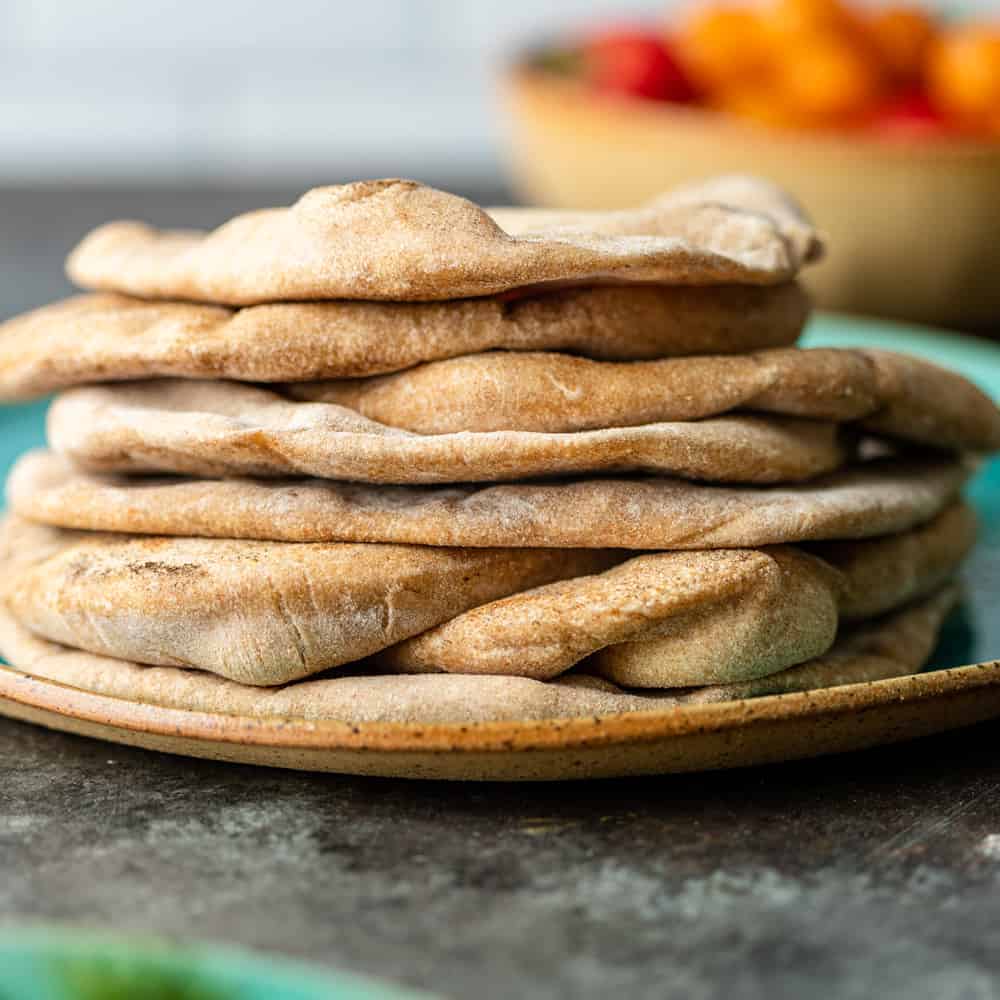
Every culture along the Silk Road has its own unique version of bread. We have Indian Naan Bread, Turkish Sesame Bread, and Khachapuri Georgian Cheese Bread — just to name a few.
Today’s pita bread recipe is a traditional Arabic recipe. Make this pita bread once and you’ll never go back to store-bought!
Khubz is the perfect addition to any appetizer tray with sliced veggies and dips like White Bean Hummus or Kawarma (Hummus with Lamb). It’s also the perfect accompaniment to meals like Kabsa (Arabic Chicken and Rice) and is great stuffed full of classics like Lamb Shawarma.
WHAT IS KHUBZ?
Khubz (the Arabic name for “bread”) has alternative names of khoubz, khobez, khubez, and khubooz. It’s also known as:
- Pita bread
- Arabic bread or Arab bread
- Syrian bread
- Lebanese flatbread
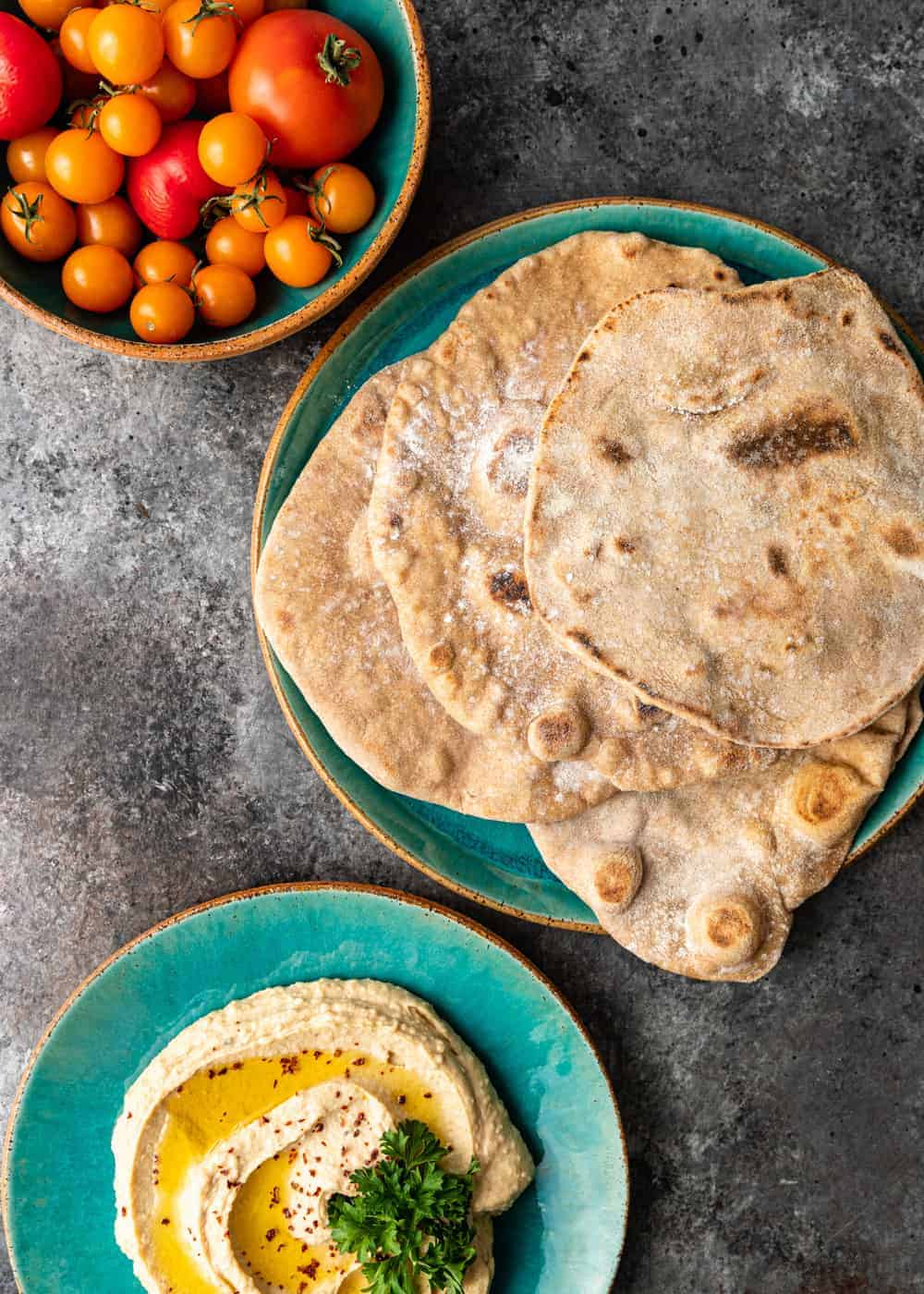
INGREDIENT NOTES AND SUBSTITUTIONS
- Active Dry Yeast – Also called double-rise yeast, this crucial ingredient allows for 2 rounds of dough rising. Rapid-rise or quick-rise yeast will not work as substitutes.
- Water – Lukewarm water is very important for this step. If the water is too hot, it might kill the yeast. Conversely, if it is too cold, the yeast won’t activate at all.
- Sugar – A bit of white sugar feeds the yeast and sets the whole magical process in motion.
- Flour – I like an equal combination of whole wheat and bread flour for this pita bread recipe. If desired, you can use only bread flour.
- Salt – Kosher salt or sea salt are great options. Avoid regular table salt for this recipe.
- Oil – Olive oil is perfect, or you can substitute another oil with a neutral flavor.
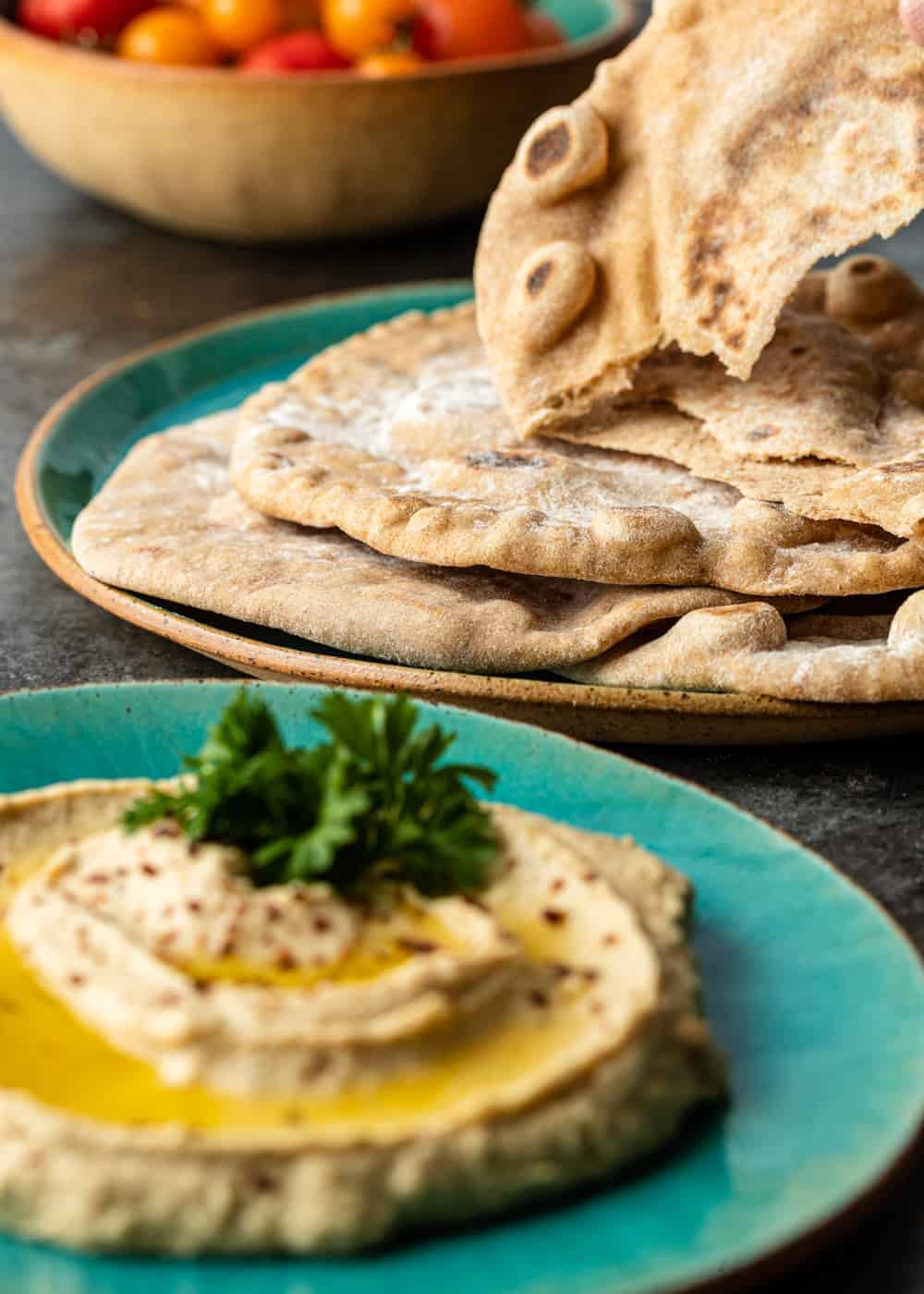
HOW TO MAKE PITA BREAD
- Proof the Yeast. In a large mixing bowl, dissolve the yeast in ¼ cup warm water. Add sugar, wait until it froths, then add in the other ¼ cup of warm water.
- Mix in Flour. Fit the mixer with the dough hook attachment and mix in 1 ½ cups of flour. This “sponge” mixture should resemble pancake batter. Allow it to rest for 10 minutes.
- Add Remaining Flour. Mix in the salt and one tablespoon of olive oil. Then, add the remaining 1 ½ cups flour. Turn the mixer to low and mix until the dough comes together.
- Mix the Dough. Increase the speed and mix for another 10 minutes until the dough becomes shiny, smooth, and elastic. Remove dough to a floured surface.
- Let it Rise. Use the remaining olive oil to coat a mixing bowl, then roll the dough ball inside. Cover the bowl with a piece of plastic wrap or a damp tea towel. Place it in a warm, draft-free place and let rise for 2 hours.
- Knead & Divide. Punch down the dough and knead for about 3 minutes. Divide the dough in half, and cover one-half with the damp tea towel. Divide the other half and roll into 4 equal dough balls.
- Flatten Dough Balls. On a floured surface, flatten each ball into a disc. Dust with flour before transferring to a floured towel or silicone mat. Repeat with the rest of the dough. Allow the discs to rise and rest for about 20 minutes at room temperature.
- Skillet Method: Place a cast iron skillet over high heat and cook each pita for 1 to 1 ½ minutes per side. They will puff up like balloons.
- Oven Method: Alternatively, you can place an empty baking sheet in a 500 degrees F oven. Remove the pan, place 2 pitas at a time on the hot baking sheet, and bake for about 3-5 minutes or until they puff up like a balloon.
- Wrap to Keep Soft. Wrap the pita bread in a towel as you cook to help keep them soft, pliable, and delicious.

How Do You Keep Pita Bread From Getting Hard?
Due to its thin nature, pita bread is notorious for drying out and hardening rather quickly.
For maximum freshness, store your leftover khubz in an airtight container at room temperature and enjoy within 3 days. You can also wrap and store leftovers in the freezer for up to 3 months.
Before eating, wrap each flatbread in a slightly damp paper towel and microwave for about a minute. It should be perfectly soft again!
Why Did My Pita Bread Not Puff?
High heat is essential for this pita bread recipe to be successful. Whether using the oven or stovetop, set the heat to maximum and thoroughly preheat your pan before adding the dough. This creates steam, which is essential for puffing up these pitas.
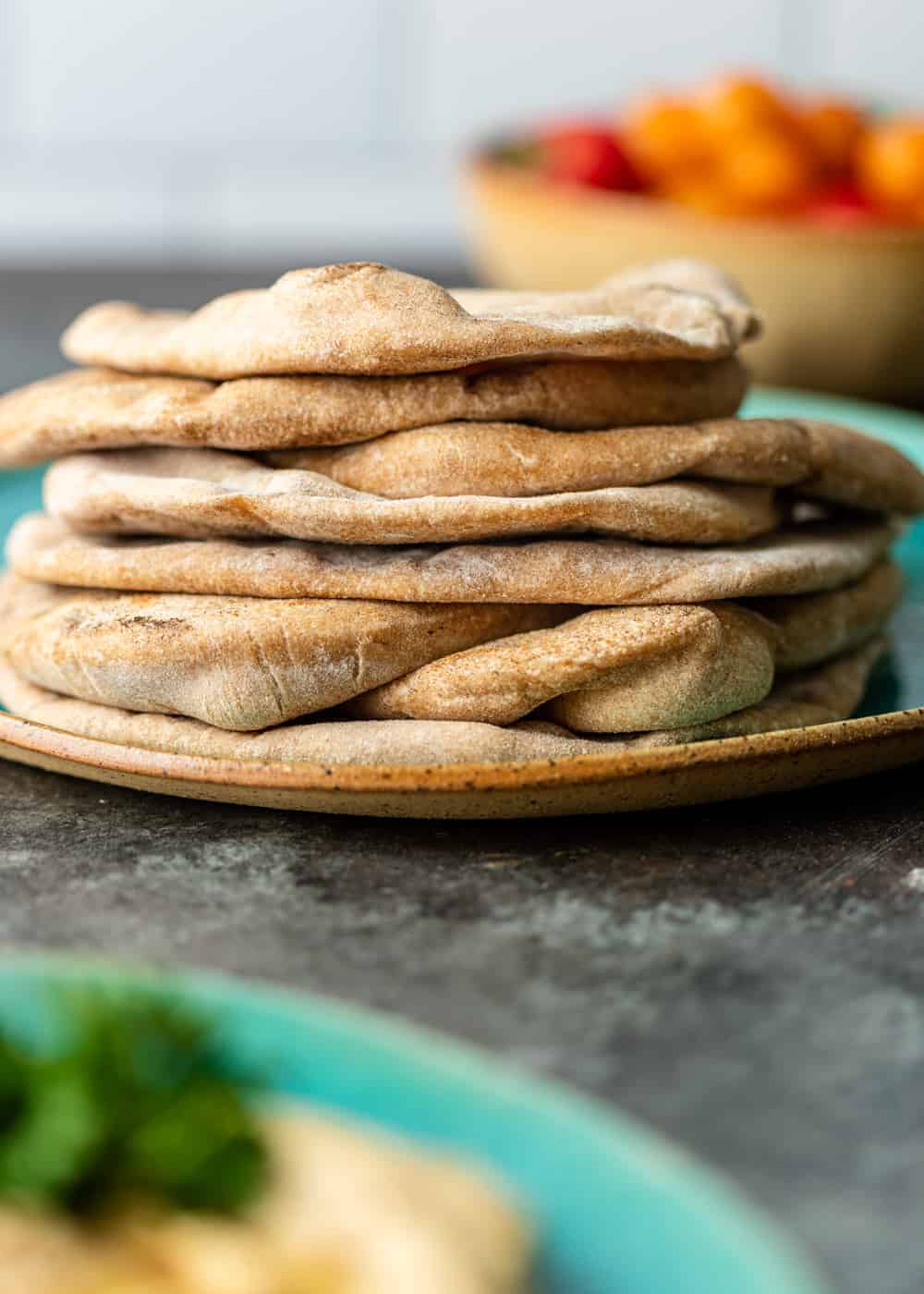
What’s the Difference Between Naan and Pita Bread?
Naan is an Indian flatbread, whereas pita bread is more commonly found in Middle Eastern and Mediterranean cuisine.
Naan has more fat, which makes it moister and softer than khubz. Naan can include eggs, ghee, yogurt, and a variety of herbs and spices.
Pita bread, on the other hand, is a much leaner, lighter, and simple bread. Khubz also has the signature “pita pocket” that makes it perfect for stuffing full of goodies.
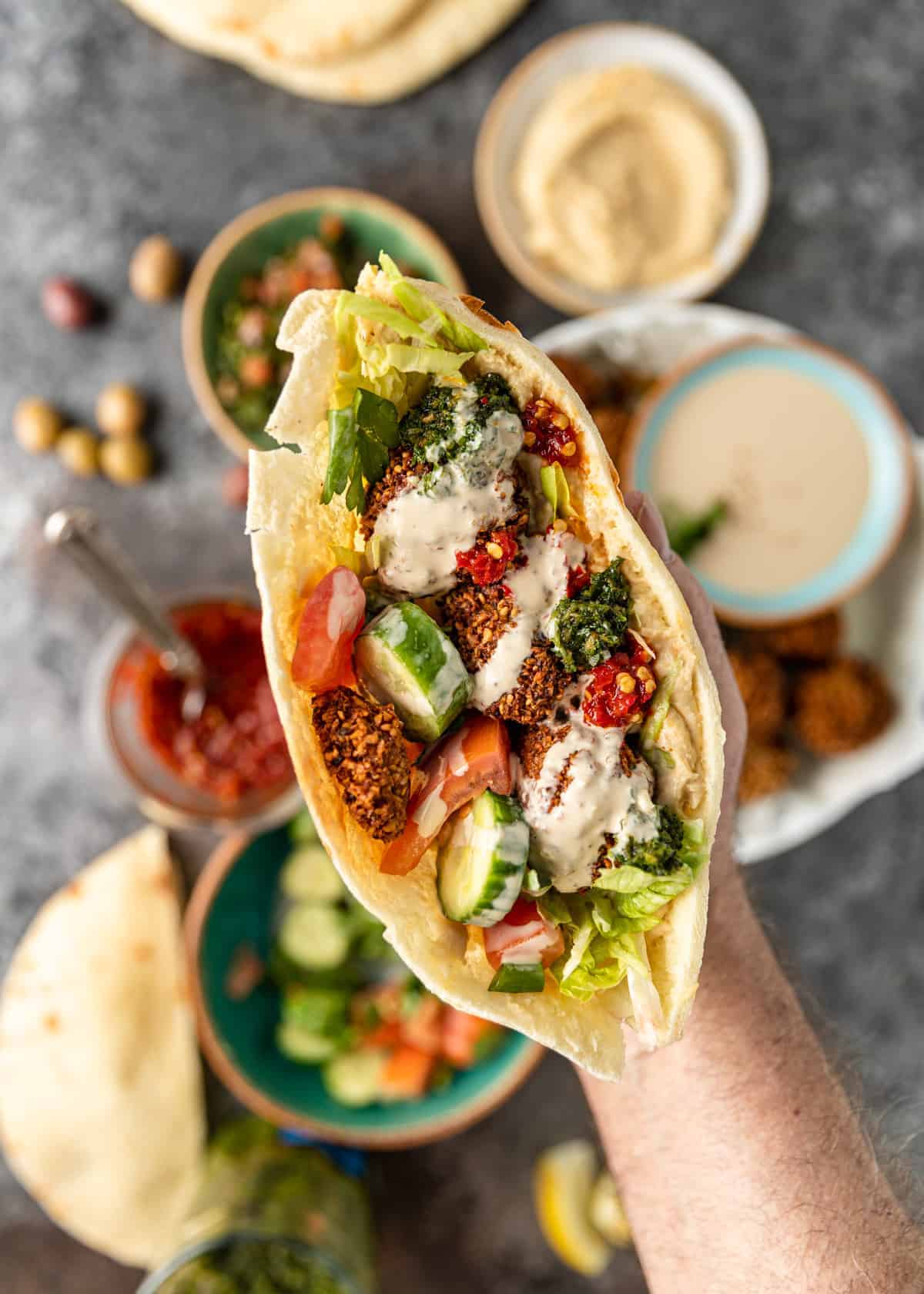
This recipe post, originally published on Silk Road Recipes January 2021, was updated with new content, photos and/or video in May 2023.

Pita Bread Recipe (Khubz)
Ingredients
Instructions
- Dissolve the yeast in a large mixing bowl with 1/4 cup warm water. Add the sugar and when it starts to froth, add remaining 1 1/4 cups of water.
- Add 1 1/2 cups flour, and using dough hook attachment, mix. This is called a "sponge" mixture. Let this rest for 10 minutes. It will look like pancake batter.
- Add the salt and tablespoon of olive oil to the sponge and mix together. Add remaining 1 1/2 cups of flour, and using dough hook on low, mix until dough comes together.
- Turn speed up and mix dough for 10 minutes. Dough will become elastic, shiny and smooth. Remove the dough and set aside on floured surface while you oil the mixing bowl.
- Rub remaining tablespoon of olive oil on the inside of the mixing bowl and roll dough ball all over to coat. Flip it over, cover with a damp tea towel or plastic wrap. Allow to rise for 2 hours in a draft free, warm place (See Note 2).
- Punch dough down and knead again for 3 minutes. Divide dough in half. Divide first half into 4 equal pieces, cover other half with damp tea towel or plastic wrap.
- Roll each dough piece into a ball. Flatten each ball on a lightly floured surface and roll 7-8" in diameter, about an 1/8 to 1/4" thick. Dust with flour and place on a floured towel or tray lined with a silicon mat. Repeat with remaining dough. Allow to rest and rise again, about 20 minutes at room temperature.
Skillet Baking Method
- Heat a heavy bottomed skillet (cast iron) over a high flame and cook each piece for 1 to 1 ½ minutes per side (these will puff up like balloons).
- Wrap breads in a towel to keep warm and pliable as you repeat with remaining dough pieces.
Oven Baking Method
- Place a baking sheet in the center of a 500°F oven.
- Remove baking sheet from oven, sprinkle with flour and place 2 pieces on the hot baking sheet. Bake 3-5 minutes until lightly browned (these will puff up like balloons).
Video
Notes
- I like to use 1 1/2 cups bread flour with 1 1/2 cups whole wheat flour. Feel free to use 3 cup bread flour if you choose.
- I often times will either place the bowl in the microwave and leave it be or turn the clothes dryer on for a minute, turn it off and place the bowl to rise in the dryer (being sure NOT to turn it on while in there).
- Recipe adapted from Claudia Roden’s recipe in The New Book of Middle Eastern Food.
Nutrition
The information shown is an estimate provided by an online nutrition calculator. It should not be considered a substitute for a professional nutritionist’s advice.


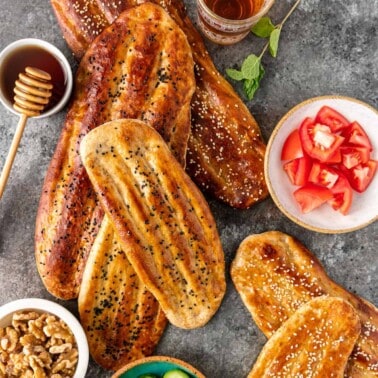
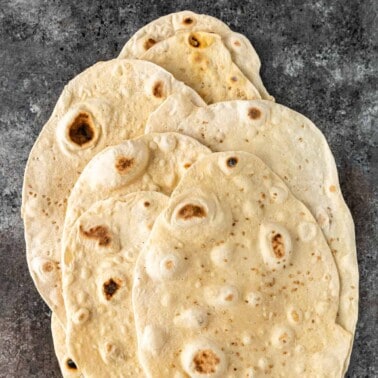
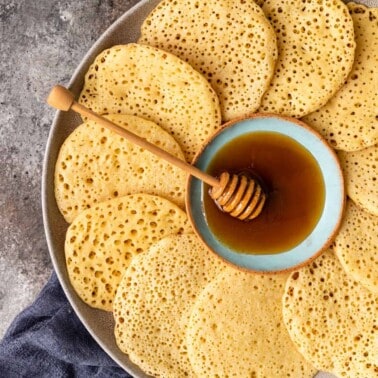
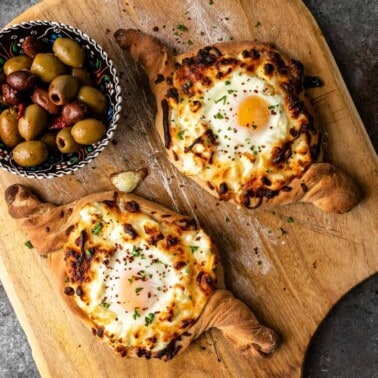








Mmmmmm trying It tonight. Thank you 👍
Thanks Denyse, let me know what you think. 🙂
Nice recipe. Small correction to your intro though though; Naan IS leavened (common misconception and frequently misreported!); its chapatis, rotis etc that are not.
Thanks! Joe you are correct, my mistype there. Information updated to reflect!
These are so easy and soft. Thanks!
Indeed… and delicious!
This looks great and so easy! My family is going to love this recipe! Can’t wait to make this!
Yes, please! My family would go crazy over these pita bread!
We LOVE pita bread and this is seriously delicious!!
I love making pizzas and pita bread! This recipe is great for the whole wheat option!
Your photos are gorgeous and gave me confidence to make it myself! So delicious and surprisingly easy.
This Khubz is seriously making me hungry!
I’ve been looking for a whole wheat pita bread and this did not disappoint!!
I am so glad you came across this recipe then!
I like that they are whole wheat because they are a whole lot better for you. I also give them a deep hardy flavor. They are so good, I recommend trying them.